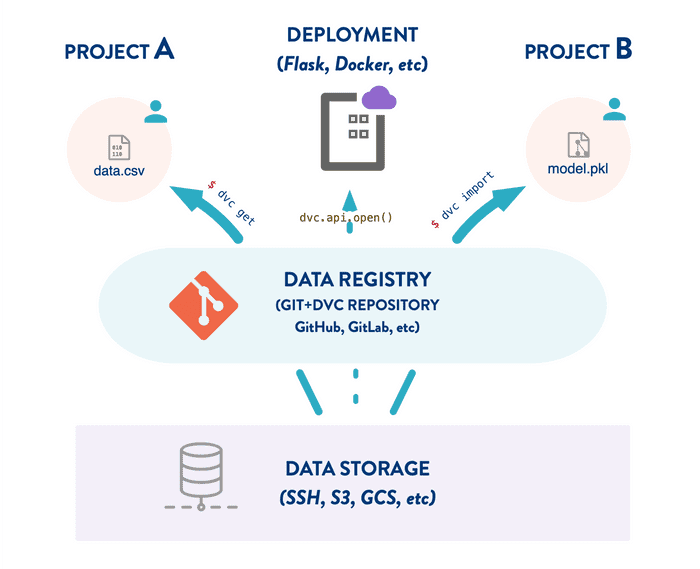Data Registries
One of the main uses of DVC repositories is the versioning of data and model files. DVC also enables cross-project reusability of these data artifacts. This means that your projects can depend on data from other DVC repositories — like a package management system for data science.
We can build a DVC project dedicated to versioning datasets (or data features, ML models, etc.). The repository would have all the metadata and change history for the data it tracks. We could see who changed what and when, and use pull requests to update data like we do with code. This is what we call a data registry — data management middleware between ML projects and cloud storage.
Advantages of data registries:
- Reusability: reproduce and organize feature stores with a simple CLI
(
dvc getanddvc importcommands, similar to software package management systems likepip). - Persistence: remote storage (e.g. an S3 bucket) controlled by the DVC registry improves data security. There are less chances someone can delete or rewrite an ML model, for example.
- Storage optimization: centralize data shared by multiple projects in a single location (distributed copies are possible too). This simplifies data management and optimizes space requirements.
- Data as code: leverage Git workflows such as commits, branching, pull requests, reviews, and even CI/CD for your data and models lifecycle. Think "Git for cloud storage", but without ad-hoc conventions.
- Security: registries can be setup with read-only remote storage (e.g. an HTTP server).
Building registries
Adding datasets to a registry can be as simple as placing the data file or
directory in question inside the workspace, and track it with
dvc add. A regular Git workflow can be followed with the .dvc files that
substitute the actual data (e.g. music/songs.dvc below). This enables team
collaboration on data at the same level as with source code:
This sample dataset actually exists.
$ mkdir -p music/songs
$ cp ~/Downloads/millionsongsubset_full music/songs
$ dvc add music/songs/
$ git add music/songs.dvc music/.gitignore
$ git commit -m "Track 1.8 GB 10,000 song dataset in music/"The actual data is stored in the project's cache, and can be pushed to one or more remote storage locations so the registry can be accessed from other locations and by other people:
$ dvc remote add -d myremote s3://my-bucket/dvc-storage
$ dvc push💡 A good way to organize DVC repositories into data registries is to use directories to group similar data, e.g.
images/,natural-language/, etc. For example, our dataset registry has directories likeget-started/anduse-cases/, matching parts of this website.
Using registries
The main methods to consume artifacts from a data registry are
the dvc import and dvc get commands, as well as the Python API dvc.api.
But first, we may want to explore its contents.
Listing data
To explore the contents of a data DVC repo in search for the right data, use the
dvc list command (similar to ls and 3rd-party tools like aws s3 ls):
$ dvc list -R https://github.com/iterative/dataset-registry
.gitignore
README.md
get-started/.gitignore
get-started/data.xml
get-started/data.xml.dvc
images/.gitignore
images/dvc-logo-outlines.png
...Both Git-tracked files and DVC-tracked data (or models, etc.) are listed.
Data downloads
dvc get is analogous to using direct download tools like wget (HTTP),
aws s3 cp (S3), etc. To get a dataset from a DVC repo, we can run something
like this:
$ dvc get https://github.com/example/registry music/songsThis downloads music/songs from the project's
default remote and places it in the
current working directory.
Data import workflow
dvc import uses the same syntax as dvc get:
$ dvc import https://github.com/example/registry images/facesBesides downloading the data, importing saves the information about the
dependency from the local project to the data source (registry repo). This is
achieved by generating a special import .dvc file, which contains this
metadata.
Whenever the dataset changes in the registry, we can bring data up to date in
with dvc update:
$ dvc update faces.dvcThis downloads new and changed files, and removes deleted ones, based on the
latest commit in the source repo; And it updates the .dvc file accordingly.
Note that
dvc get,dvc import, anddvc updatehave a--revoption to download data from a specific commit of the source repository.
Using DVC data from Python code
Our Python API, included with the dvc package installed
with DVC, includes the open function to load/stream data directly from
external DVC projects:
import dvc.api.open
model_path = 'model.pkl'
repo_url = 'https://github.com/example/registry'
with dvc.api.open(model_path, repo_url) as fd:
model = pickle.load(fd)
# ... Use the model!This opens model.pkl as a file descriptor. This example illustrates a simple
ML model deployment method, but it could be extended to more advances
scenarios such as a model zoo.
See also the dvc.api.read() and dvc.api.get_url() functions.
Updating registries
Datasets evolve, and DVC is prepared to handle it. Just change the data in the
registry, and apply the updates by running dvc add again:
$ cp 1000/more/images/* music/songs/
$ dvc add music/songs/DVC modifies the corresponding .dvc file to reflect the changes, and this is
picked up by Git:
$ git status
...
modified: music/songs.dvc
$ git commit -am "Add 1,000 more songs to music/ dataset."Iterating on this process for several datasets can give shape to a robust registry. The result is basically a repo that versions a set of metafiles. Let's see an example:
$ tree --filelimit=10
.
├── images
│ ├── .gitignore
│ ├── cats-dogs [2800 entries] # Listed in .gitignore
│ ├── faces [10000 entries] # Listed in .gitignore
│ ├── cats-dogs.dvc
│ └── faces.dvc
├── music
│ ├── .gitignore
│ ├── songs [11000 entries] # Listed in .gitignore
│ └── songs.dvc
├── text
...And let's not forget to dvc push data changes to the
remote storage, so others can obtain them!
$ dvc push